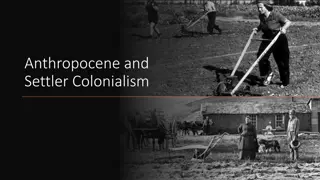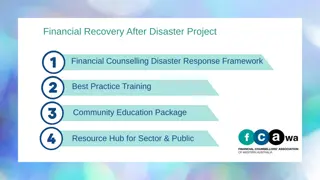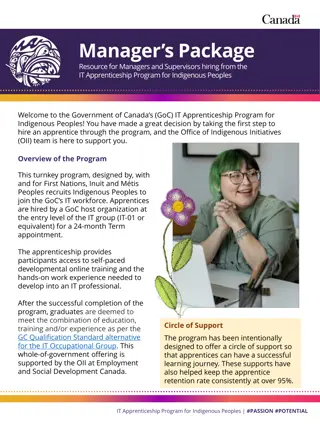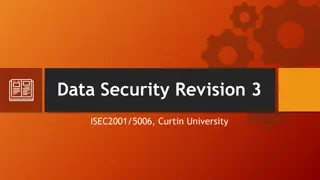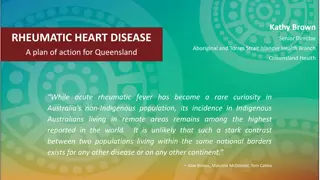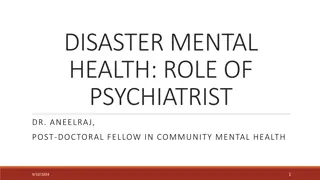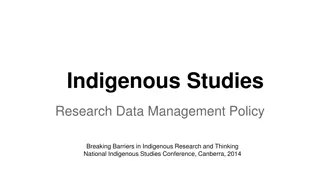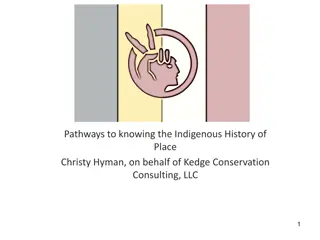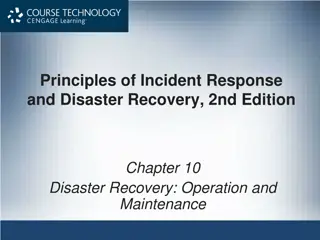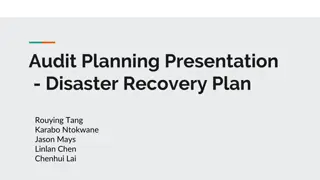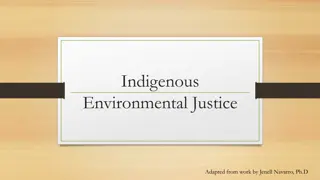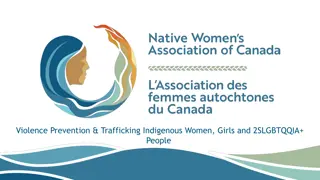Understanding Indigenous Communities in Disaster Recovery
Increased understanding of intrinsic strengths and unique impacts of disasters on Indigenous communities, role of Indigenous community-controlled organizations, importance of connection to Country, and need for engagement with Indigenous communities by emergency management agencies. Disasters have unique impacts on Indigenous Peoples due to deep connections between land, culture, history, colonization, and identity. Addressing health and social inequalities, such as overcrowded households and lack of infrastructure, is vital in disaster risk reduction efforts.
Download Presentation

Please find below an Image/Link to download the presentation.
The content on the website is provided AS IS for your information and personal use only. It may not be sold, licensed, or shared on other websites without obtaining consent from the author. Download presentation by click this link. If you encounter any issues during the download, it is possible that the publisher has removed the file from their server.
E N D
Presentation Transcript
Working with Indigenous communities in disaster recovery
We acknowledge the First Peoples of Australia and their ongoing strength in practising the world s oldest living culture. We acknowledge the Traditional Owners who have occupied and cared for the lands and waterways on which we depend for thousands of years. We acknowledge the (insert local Indigenous peoples and land) and pay our respects to their Elders past and present.
Indigenous Communities in [Insert your region/local area]
Objectives Increased understanding of: Intrinsic strengths and unique impacts of disasters on Indigenous communities Role of Indigenous community controlled organisations in planning for and recovering from disasters Importance of connection to Country Need for engagement with Indigenous communities by emergency management agencies
An Indigenous Perspective of Disaster Recovery Bhiamie Williamson
Connection to Country For Indigenous peoples, Country is more than a landscape. Indigenous peoples tell and retell stories of how Country was made, and continue to rely upon its resources food, water, plants and animals to sustain traditional ways of life. Healing Country, healing culture really matters. Until you heal Country and heal culture you can t heal people. Sharon Riley, MINGAAN Wiradjuri Aboriginal Corporation (Lithgow Mercury 12 November 2021)
Disasters have unique impacts on Indigenous Peoples When disasters damage Country, the harm felt by Indigenous peoples can be particularly profound due to the deep connections between land, culture, history, colonisation and identity. Trauma can also arise from needing to relocate, and losing or being separated from loved ones and community . Recovery Capitals and Indigenous Peoples Resource
Health and social inequalities - Risk factors Indigenous communities have distinct risk factors that are compounded in a disaster: Overcrowded and multigenerational households Poor health of residents Lack of appropriate infrastructure Lack of access to transport Poor access to roads to evacuate.
Aboriginal people are disproportionately affected by the impacts of the fires due to existing structural and financial inequalities, a backdrop of historical and intergenerational trauma, and the significant impacts that bushfires and bushfire protection has on Country and cultural heritage. Victorian Government (2020), 2019-20 Victorian Government Aboriginal Affairs Report (p.12)
The Inquiry acknowledges that Aboriginal communities across the State were greatly affected by the bushfires The Inquiry was disappointed to learn that in some communities Aboriginal people felt unwelcome at evacuation centres, and in some cases support services were reluctant to provide immediate relief. These experiences compounded the trauma they had already experienced as a result of the bushfires, and in some cases led to people putting themselves at risk as they feared how they would be treated. Owens & O Kane (2020), Final Report of the NSW Bushfire Inquiry(p.466)
Recovery approaches should be respectful of the history, culture, strengths and circumstances of affected Indigenous communities, including deep connectedness RECAP Guide: Indigenous Peoples and Recovery Capitals
Creating culturally safe places in evacuation and recovery centres Trauma can be worsened by disaster response and recovery services, including through racist encounters and culturally unsafe processes. Mainstream services and grants often fail to account for the particular experiences of Indigenous peoples. (RECAP) Creating Safe Places Publicly acknowledge the local Traditional Owners of the land that the centre is located on Create a separate and safe space for Elders Have adequate facilities for families with children and babies Invite the local Indigenous organisations to be present in evacuation and recovery centres Provide evacuation and recovery centre staff and volunteers with cultural awareness training.
Intrinsic strengths of Indigenous communities Indigenous communities are often referred to as vulnerable , however these vulnerabilities are not inherent characteristics of Indigenous peoples, but stem from systems of inequity There are many strengths that exist within Indigenous communities. These include having: extensive familial and cultural networks that can be mobilised in times of crisis advocates that are quick to bring attention to community needs healing frameworks that are called upon to support communities in times of hardship community-controlled organisations that have well-established and trusting relationships with communities.
Indigenous community organisations are an asset in recovery Indigenous community-controlled organisations are governed by their communities They know their community and can provide critical information about local populations There is a level of trust, or at least familiarity, between Indigenous peoples and the organisation Indigenous community members are more likely to access these organisations before accessing non-Indigenous organisations or government agencies.
Planning for recovery with Indigenous Communities Establish authentic relationships of partnership with Indigenous peoples as valued and equal recovery decision-makers, before disaster hits. How have Indigenous peoples been impacted by this disaster? Consider residents, distinct communities and legal rights and interest in the land as First Peoples. Consider also the deep connections between land, culture, history, colonisation and identity. Develop and maintain strong working relationships with local Indigenous organisations. Be guided by these organisations and Elders to centre Indigenous peoples voices in developing recovery strategies which minimise the risks of exacerbating existing trauma and vulnerability. Strategies should recognise and build on the strength and resilience of Indigenous communities. RECAP Guide: Indigenous Peoples and Recovery Capitals
Group Discussion on: How can you strengthen partnerships with local Indigenous leaders and Indigenous community-controlled organisations? What can you do in your role, in your organisation, to work more closely with Indigenous communities in planning for recovery?
Take away messages Indigenous peoples are disproportionately affected by the impacts of disasters due to existing structural and financial inequalities When disasters damage Country the harm felt by Indigenous peoples can be profound Indigenous communities have intrinsic strengths that are often overlooked in recovery Indigenous community- controlled organisations have an important role to play in planning for recovery Culturally informed approaches are essential for recovery and healing
Suggested next steps Review your emergency and recovery plans. How do your planning processes include local Indigenous Communities? How do your plans reflect: the strengths and assets of Indigenous peoples the unique needs of Indigenous peoples in evacuation and recovery the Indigenous community-controlled organisations who can provide information and support the formal recognised rights over Country and cultural heritage of local Indigenous peoples Meet with local Indigenous Elders and community-controlled organisations to plan together how local Indigenous communities can best be supported through an emergency and in recovery. Establish formal mechanisms of engagement such as a Community Organisations Recovery Reference Group that includes Indigenous community-controlled organisations. Encourage recovery practitioners from government and non-government agencies to undertake Indigenous cultural awareness training.
Recovery Exercising Toolkit The Working with Indigenous Communities in Recovery Module Overview, Slide Deck and other resources are available in the Recovery Exercising Toolkit which can be found on the AIDR Knowledge Hub in the Recovery Collection.
Where to find out more Williamson, B (2022). Aboriginal community governance on the frontlines and faultlines in the Black Summer Bushfires (CAEPR Discussion Paper No. 300/2022). Centre for Aboriginal Economic Policy Research, ANU Aboriginal Community Governance on the Frontlines and Faultlines in the Black Summer Bushfires | Centre for Aboriginal Economic Policy Research (anu.edu.au) Recovery Capitals (ReCap), supports wellbeing after disasters with evidence-based resources for people and organisations engaged in recovery. Quinn P, Williamson B, Gibbs L. Recovery Capitals and Indigenous Peoples Resource. Melbourne, Australia: Bushfire and Natural Hazards Cooperative Research Centre. April 2021. Recovery Capitals Indigenous Peoples and Recovery Capitals Resource Indigenous Peoples and Recovery Capitals - Phoenix Australia Disaster Mental Health Hub ABC Podcasts After the Disaster, Episode 12 Communities with trauma Ep 12 | Communities with Trauma - ABC



